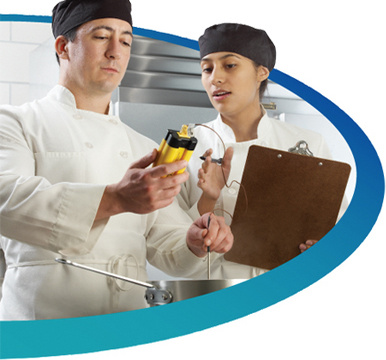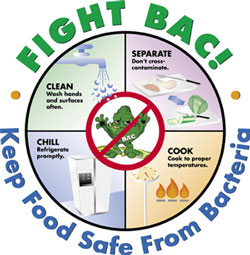Dine Company – The Restaurant Store is committed to helping you maintain and implement the best food safety plan. There are several crucial steps that an operator must take in the beginning stages of developing a food safety plan.
F irst and foremost is to contact your local Health Department Food Service Inspection team. The health department will provide a comprehensive, up to the minute set of guidelines for you to follow. Secondly, get key employees Serve Safe certified. The health department will require you to have a certain number certified, but the more the merrier. The more informed and educated your staff is, the safer your building will be.
irst and foremost is to contact your local Health Department Food Service Inspection team. The health department will provide a comprehensive, up to the minute set of guidelines for you to follow. Secondly, get key employees Serve Safe certified. The health department will require you to have a certain number certified, but the more the merrier. The more informed and educated your staff is, the safer your building will be.
Dine Company is a proud distributor of Taylor Thermometers. Taylor is world-renowned as the leader in the food temping business. Taylor has more than 150 years of expertise in product development and manufacturing. Taylor provides end-users of their product with very helpful and insightful ways to use their cutting edge technology when implementing a food safety plan:
Taylor Tells Us:
This guide takes a look at how food is handled from the truck to the table and the temperature safety standards that are defined by the latest government standards.
1. Receiving
Before accepting deliveries, make sure the temperature is within prescribed limits. Check both surface and interior temperatures: use either an Instant Read or a Pocket Digital Thermometer for a quick interior check and an Infrared Thermometer for surface temperatures. Refrigerated foods — no higher than 41°F. (5°C.). Frozen foods-no higher than 0°F. (-17.8°C.) — use a Hand-held Thermocouple Thermometer with a Frozen Food Probe for quick, easy inspection of frozen food deliveries. Discard dry goods if there is any dampness, discoloration or if the packaging is damaged.
Remember: Always refuse foods that show any signs of spoilage!
2. Storing
All foods must be properly stored to minimize the risk of bacterial growth or contamination. Refrigerated foods must be stored at 41°F. (5°C.) or lower — use separate refrigerator thermometers for different food storage temperatures. Frozen foods need an air temperature below 0°F. (-17.8°C.). Use two freezer thermometers — one at the warmest point, the other at the coldest — to monitor air temperature.
Dry stored foods should be kept at 50°F. (10°C.) in a well-lit, ventilated room with a maximum of 60% relative humidity. Use a remote sensor thermometer and humidity gauge monitor storage room temperatures and humidity levels.
Remember: Check storage temperatures at least twice each day!
3. Preparing/Cooking
Foodborne pathogens are killed by safe cooking temperatures. Use a Taylor Deep Fry Dial Thermometer to check deep-frying oil temperatures to prevent cooking the surface of foods too quickly. Use an Infrared Thermometer to ensure grills, fryers and ovens maintain the right temperature for uniform cooking and use pocket thermometers and thermocouple thermometers to ensure that 1999 FDA Guidelines for safe internal temperatures are consistently met.
4. Serving/Holding
Hold foods out of the Danger Zone- hot foods above 140°F (60°C) and cold foods below 41°F (5°C) – to inhibit bacteria. Always use thermometers – either a Taylor Hot/Cold Holding Cabinet Thermometer or Hand-held Thermocouple Thermometer with an Air Probe – to check air temperatures in holding cabinets and under heat lamp warmers.
Remember: Built-in thermostats may be misleading because they only measure air temperature immediately adjacent to sensors which may not be uniform throughout the holding area.
5. Cooling
After cooking, chill foods — especially meats — as rapidly as possible to minimize their time in the Danger Zone and limit bacterial growth. Chill from 140°F (60°C) to 70°F (21°C) within 2 hours, then from 70°F (21°C) to 41°F (5°C) within 4 hours.
Remember: The larger the surface area, the faster the food will cool. Cut roasts into smaller portions and distribute liquids among several smaller pans to speed chill time.
6. Reheating
Some bacteria survive cooking and multiply to dangerous levels during chill-down. Food must be reheated to an internal temperature of 165°F. (74°C.) to eliminate new pathogens. Use an Instant Read or Hand-held Thermocouple Thermometer to ensure all foods are reheated adequately. Reheating kills pathogens, it won’t eliminate toxins, such as that produced by Staphylococcus aureus, so remember these important rules:
Use an Instant Read or Hand-held Thermocouple Thermometer to ensure all foods are reheated adequately. Reheating kills pathogens, it won’t eliminate toxins, such as that produced by Staphylococcus aureus, so remember these important rules:
- Never reheat food more than 2 days old
- Never add old foods to new
- Reheat foods only once-then discard
- Enforce strict personal hygiene standards.
This is invaluable information. Post this informative sheet on every wall in your kitchen and then head to Dine to stock up on the Taylor products you need to keep you and your guests safe, healthy and informed.

